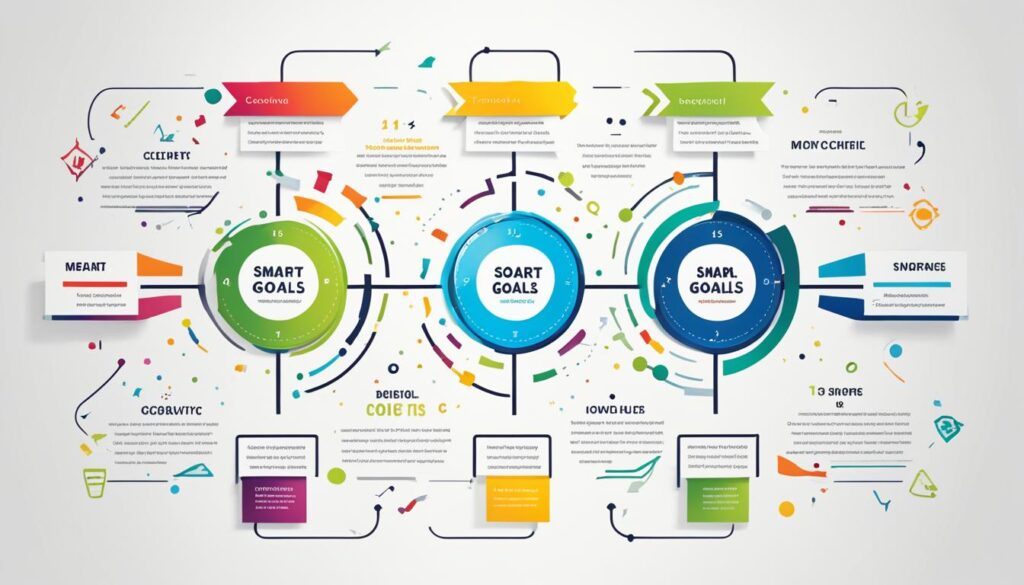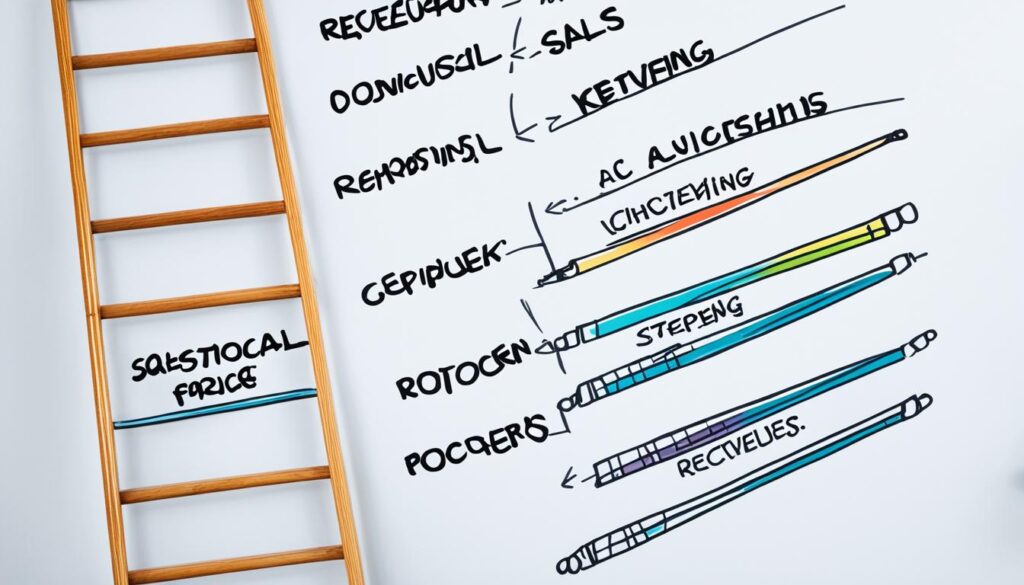Achieve Success with Work Goals Examples for Evaluation

Do you ever find yourself wondering how to take your career to the next level? Are you unsure about what objectives to set for your professional growth? The key to realizing your potential lies in setting the right work goals. But what are the examples of work goals that can truly propel your career forward? How do you evaluate these goals effectively to track your progress and ensure success?
Setting performance metrics and establishing career development objectives are crucial steps in the journey toward your desired professional growth. Understanding the importance of goals and how to evaluate them empowers you to make deliberate choices that align with your aspirations and accelerate your path to success.
In this article, we will explore the significance of work goals examples for evaluation and provide you with valuable insights and practical strategies to set career development objectives and professional growth targets effectively. Join us as we uncover the power of goal setting in driving your career to new heights!
Key Takeaways:
- Setting the right work goals is essential for achieving professional growth.
- Evaluating your goals allows you to track your progress and make necessary adjustments.
- Career development objectives should be aligned with your aspirations and ambitions.
- Setting clear performance metrics helps you measure your success and identify areas for improvement.
- By mastering the art of goal setting and evaluation, you can unlock your full potential and propel your career forward.
What are Performance Evaluations?
Performance evaluations are formal assessments of an employee’s work. They are crucial for assessing employee performance, identifying strengths, and areas for improvement. By conducting regular performance evaluations, organizations can effectively measure employees’ performance against job responsibilities, set goals, and provide constructive feedback.
Performance evaluations involve a systematic process that consists of several key components:
- Setting Goals: Performance evaluations begin by setting clear and measurable goals for employees. These goals align with the organization’s objectives and help employees understand expectations and priorities.
- Monitoring Progress: Throughout the assessment period, managers or supervisors regularly monitor employees’ progress towards their goals. This ensures that employees stay on track and take necessary actions to achieve desired outcomes.
- Measuring Performance: Performance evaluations involve measuring employee performance against predetermined performance metrics. This provides an objective evaluation of employees’ achievements and identifies areas for improvement.
- Providing Feedback: Feedback is a crucial component of performance evaluations. Managers or supervisors provide constructive feedback to communicate strengths and areas for improvement. This feedback helps employees gain insights into their performance and make necessary adjustments.
- Development Planning: Based on the performance evaluation outcomes, organizations develop individualized development plans to help employees enhance their skills and capabilities. These plans promote continuous learning and contribute to overall professional growth.
Performance evaluations play a vital role in assessing employee performance, supporting career growth, and driving organizational success. By implementing comprehensive evaluation processes, organizations can identify top performers, address performance gaps, and create a motivated and high-performing workforce.

Why are Performance Goals Important?
Setting performance goals is crucial for enhancing employee engagement, improving productivity, tracking progress, and increasing motivation. When employees have clear goals to work towards, they can focus their efforts and stay motivated to achieve them. Let’s explore the significance of performance goals in more detail:
1. Focusing Efforts
Performance goals provide employees with a sense of direction and purpose. By clearly defining what needs to be accomplished, employees can prioritize their tasks and allocate their time and energy effectively. This focus helps them stay on track and avoid getting overwhelmed by multiple responsibilities.
2. Increasing Motivation and Engagement
When employees have specific goals to strive for, they are more likely to feel motivated and engaged in their work. Goals create a sense of purpose and fulfillment, driving employees to push their limits and excel in their roles.
3. Developing Skills and Knowledge
Performance goals also serve as opportunities for employees to develop new skills and enhance their knowledge. By setting goals that require learning and growth, employees can expand their capabilities and become more valuable assets to the organization.
4. Tracking Progress
Having measurable performance goals allows employees to track their progress and evaluate their achievements. Regularly assessing progress against set targets helps employees stay accountable and provides actionable insights on areas that may require improvement.
5. Making Better Decisions
Performance goals provide employees with a framework for making better decisions. When employees are aware of the desired outcomes, they can align their actions and choices accordingly, ensuring they contribute to the overall success of the organization.
6. Improving Employee Experience, Morale, and Retention
When employees are given the opportunity to set and achieve performance goals, it enhances their overall experience at work. It fosters a sense of personal growth, job satisfaction, and recognition, which can significantly boost employee morale and increase retention rates.
By setting clear and meaningful performance goals, organizations can empower their employees to reach their full potential while driving collective success.
| Benefits of Performance Goals | Key Takeaways |
|---|---|
| Focusing efforts | Setting performance goals helps employees prioritize tasks and allocate time effectively. |
| Increasing motivation and engagement | Clear goals create a sense of purpose and encourage employees to push their limits. |
| Developing skills and knowledge | Performance goals provide opportunities for growth and learning. |
| Tracking progress | Measurable goals allow employees to assess their achievements and make necessary improvements. |
| Making better decisions | Performance goals provide a framework for aligning actions with organizational objectives. |
| Improving employee experience, morale, and retention | Setting meaningful goals enhances job satisfaction and increases employee retention rates. |
What are SMART Goals?
Setting effective goals is crucial for achieving success in any endeavor. When it comes to goal-setting, SMART goals are an invaluable framework to ensure clarity, focus, and a higher probability of achievement. SMART is an acronym that stands for Specific, Measurable, Achievable, Relevant, and Time-bound.
Let’s break down each element of a SMART goal:
- Specific: A SMART goal is well-defined and clear. It answers the questions of who, what, when, where, and why. Instead of saying, “I want to increase sales,” a specific goal would be, “I want to increase online sales by 10% in the next quarter.”
- Measurable: A SMART goal has clear criteria for measuring progress and success. It allows you to quantify your results and track your performance over time. For instance, the goal of reducing customer support response time can be measured by setting a target average response time of 24 hours or less.
- Achievable: A SMART goal is realistic and within reach. It takes into account your available resources, skills, and capabilities. While it’s important to aim high, setting unattainable goals can lead to demotivation and frustration. It’s crucial to set goals that challenge you but are still achievable.
- Relevant: A SMART goal is aligned with your overall objectives and priorities. It should contribute to your long-term success and be relevant to your area of responsibility. For example, if your goal is to improve your leadership skills, it should be pertinent to your current job role or desired career path.
- Time-bound: A SMART goal has a clearly defined timeframe or deadline. It creates a sense of urgency and accountability. Setting a deadline for your goal helps you stay focused and ensures that you allocate your time and resources effectively.
By following the SMART goal framework, you can increase your chances of achieving your desired outcomes. Here are some examples of SMART goals:
| SMART Goal |
|---|
| Increase website traffic by 20% within six months through SEO optimization and content marketing strategies. |
| Reduce customer support response time to less than 2 hours by implementing a new ticketing system and training support agents. |
| Improve employee satisfaction ratings by 10% within a year through regular staff engagement initiatives and recognition programs. |
Remember, setting SMART goals is the key to turning your aspirations into tangible achievements. Whether it’s in your personal or professional life, applying the SMART framework will help you stay focused, motivated, and on track towards success.

Common Performance Review Goals
When it comes to performance reviews, employees have the opportunity to set and work towards various goals that can enhance their professional growth and contribute to the overall success of the organization. These goals can be categorized into generic goals, which are applicable across different job roles and industries, and specific goals that are tailored to individual skill improvement and development.
Generic Performance Review Goals
Generic goals are broad objectives that can be applied to employees in various positions. By focusing on these goals, individuals can enhance their overall performance and contribute to the success of the organization. Some common examples of generic performance review goals include:
- Improving Communication Skills: Enhancing verbal and written communication abilities to effectively convey ideas and collaborate with colleagues.
- Enhancing Problem-Solving Skills: Developing critical thinking and analytical skills to identify and solve complex problems.
- Increasing Productivity and Efficiency: Improving time management and organizational skills to enhance productivity and meet deadlines.
Specific Performance Review Goals for Skill Improvement
Specific goals are tailored to individual skill improvement and development. These goals are designed to address areas for growth and enhance specific competencies. Some examples of specific performance review goals for skill improvement include:
- Developing Technical Skills: Seeking opportunities to learn and master new technologies or tools relevant to the job role.
- Enhancing Leadership Abilities: Acquiring leadership skills and taking initiative in guiding and motivating team members.
- Improving Customer Service Skills: Enhancing customer relationship management and communication skills to provide excellent service.

By setting and actively working towards these performance review goals, employees can enhance their capabilities, contribute to the success of the organization, and achieve personal and professional growth.
| Generic Performance Review Goals | Specific Performance Review Goals for Skill Improvement |
|---|---|
| Improving Communication Skills | Developing Technical Skills |
| Enhancing Problem-Solving Skills | Enhancing Leadership Abilities |
| Increasing Productivity and Efficiency | Improving Customer Service Skills |
The Importance of Setting SMART Goals in Self-Performance Reviews
When it comes to evaluating and improving your performance, goal-setting is an essential tool. By setting SMART goals in self-performance reviews, you can ensure clarity, alignment, and effective progress tracking.
SMART goals, which stand for Specific, Measurable, Achievable, Relevant, and Time-bound, provide a framework for setting targets that are both meaningful and attainable. Let’s take a closer look at each component of the SMART goal-setting framework:
- Specific: When setting your goals, be as specific as possible. Clearly define what you want to achieve and the actions required to get there.
- Measurable: It’s important to have a way to track your progress. Set tangible metrics or milestones that you can measure to determine whether you’re on track.
- Achievable: Your goals should be challenging yet realistic. Consider your current capabilities and resources to ensure that your goals are within reach.
- Relevant: Goals should be aligned with your personal and professional aspirations. They should contribute to your overall growth and development.
- Time-bound: Set a deadline or timeframe for achieving your goals. This helps create a sense of urgency and keeps you accountable.
By setting SMART goals in your self-performance reviews, you are laying the foundation for success. These goals provide clarity on what you need to accomplish, how you will measure progress, and by when you aim to achieve them.
Moreover, setting SMART goals benefits both individuals and organizations. Employers can align their employees’ goals with overall business objectives, ensuring everyone is working towards a common purpose. As an individual, SMART goals provide a roadmap for personal and professional growth.
Ultimately, setting SMART goals in self-performance reviews helps you make continuous improvements, ensures that your efforts are focused and aligned, and increases your chances of achieving both short-term and long-term success.
So, when it comes to evaluating your performance and setting goals, remember the importance of following the SMART goal-setting framework. Embark on a journey of growth, development, and self-improvement by setting SMART goals in your self-performance reviews.

Self-Performance Review Goals Examples
Setting self-performance review goals is a powerful tool for personal and professional growth. By identifying areas for improvement and setting specific goals, you can enhance your productivity, develop essential skills, and become a more effective leader. Below are some examples of self-performance review goals that can guide your growth and development:
1. Productivity Goals:
- Increasing efficiency by implementing time-saving strategies
- Setting priorities and managing tasks effectively
- Improving multitasking abilities
2. Professional Development Goals:
- Attending industry conferences and workshops to expand knowledge and stay updated
- Completing relevant professional certifications or courses
- Seeking mentorship or guidance from experienced professionals
3. Leadership Goals:
- Developing strong communication and interpersonal skills to effectively lead a team
- Taking on leadership roles in projects or cross-functional teams
- Improving decision-making abilities and problem-solving skills
4. Time Management Goals:
- Setting realistic deadlines and meeting them consistently
- Eliminating time-wasting activities and improving focus
- Prioritizing tasks and allocating time efficiently
5. Problem-Solving Goals:
- Developing analytical thinking skills to approach problems effectively
- Using creativity to generate innovative solutions
- Integrating feedback and learning from past problem-solving experiences
6. Technical Skills Goals:
- Mastering new software or tools relevant to your job role
- Improving proficiency in a specific programming language or technology
- Gaining expertise in data analysis or data visualization
7. Communication Goals:
- Enhancing active listening skills to better understand colleagues and clients
- Improving clarity and assertiveness in written and verbal communication
- Developing influential presentation and public speaking skills
8. Customer Service Goals:
- Enhancing customer satisfaction and building strong relationships
- Developing effective problem-solving skills to address customer issues
- Improving responsiveness and empathy in customer interactions
9. Project Management Goals:
- Improving project planning and organization skills
- Enhancing collaboration and teamwork within project teams
- Developing the ability to successfully manage multiple projects simultaneously
By setting self-performance review goals aligned with your career aspirations, you can focus your efforts, track your progress, and achieve significant personal and professional growth. Take the initiative to set specific goals that challenge and inspire you, and commit to your continuous self-improvement journey.
Conclusion
Setting work goals examples for evaluation is essential in driving individual and organizational success. Clear, measurable, and time-bound goals provide a roadmap for employees to continuously improve their performance and contribute to the growth and success of the organization.
By establishing specific and achievable work goals, employees can focus their efforts, enhance productivity, and track their progress effectively. These goals serve as a guiding light, allowing employees to align their daily actions with larger career Development objectives.
Through performance evaluations and the setting of work goals, individuals can strive for growth and development. Examples of such goals include enhancing communication skills, improving problem-solving abilities, developing technical proficiency, and becoming effective leaders. By regularly evaluating and refining these goals, individuals can continuously grow and adapt to the changing demands of their professional lives.






